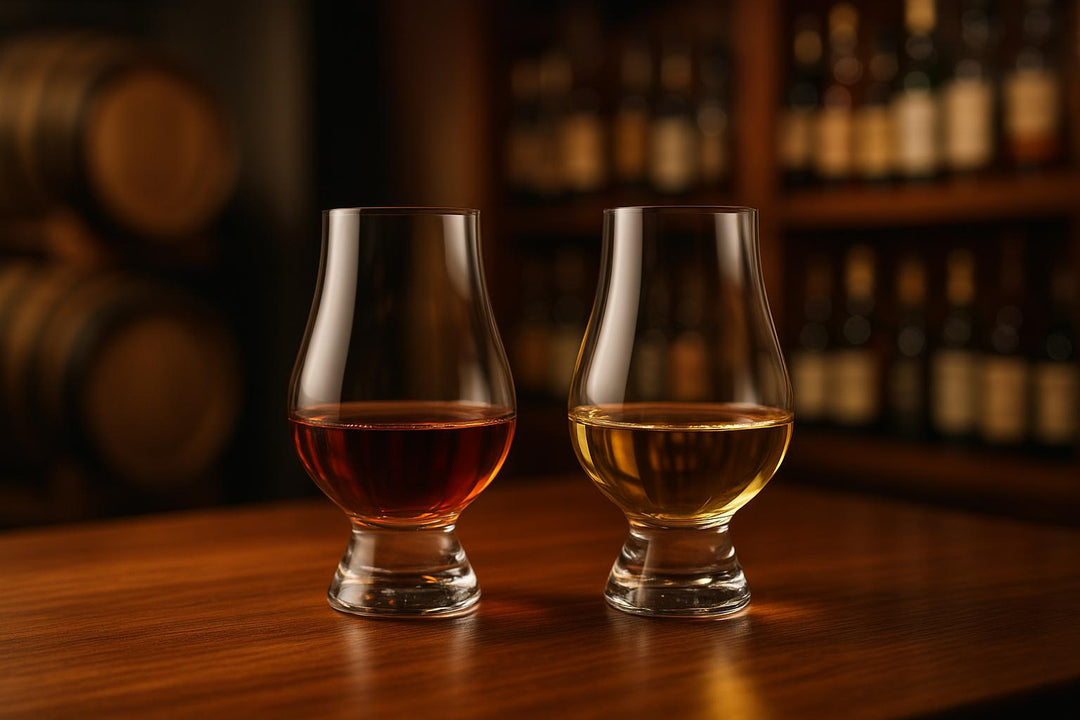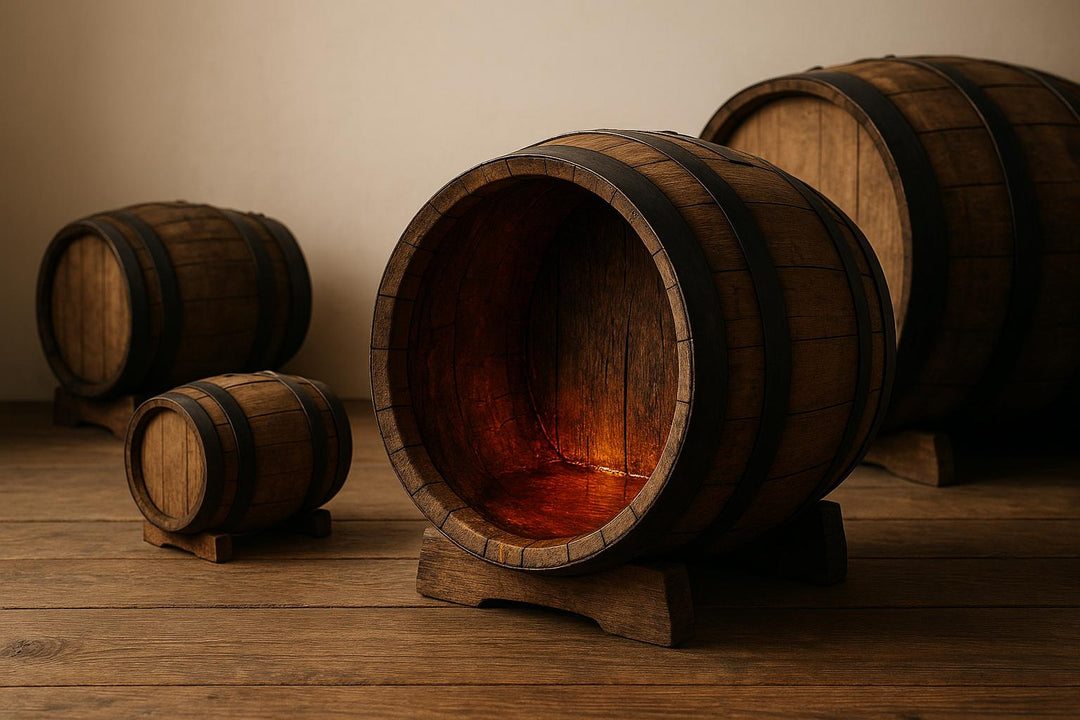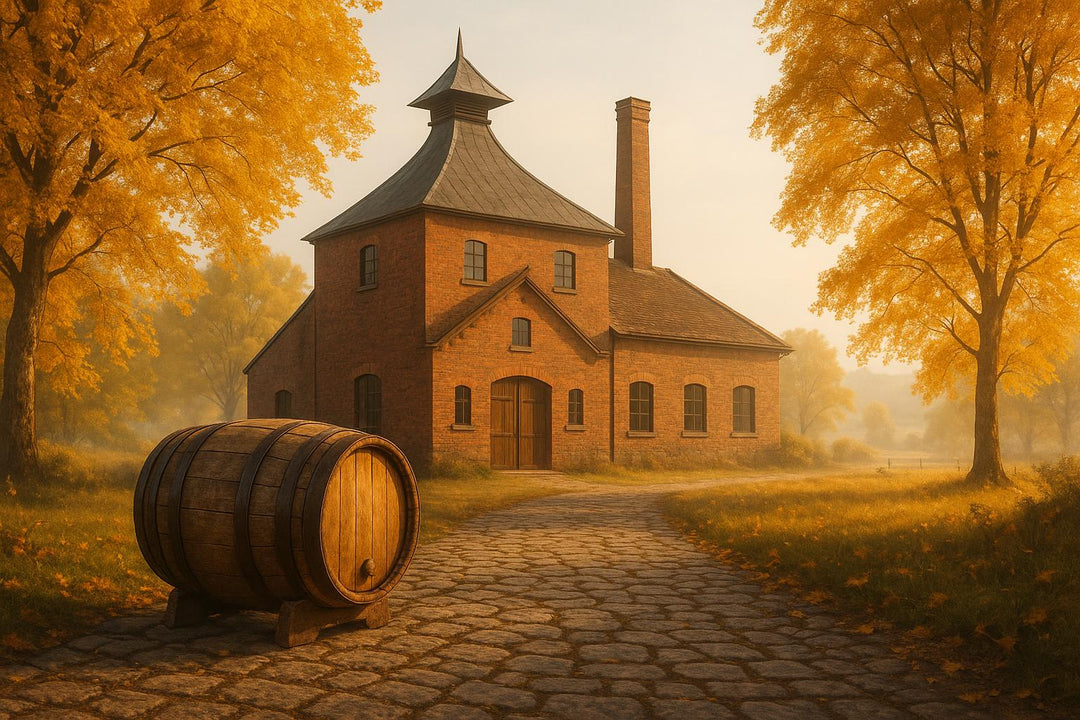Once you open a bottle of whisky, its flavour and quality can start to change due to air exposure, temperature, and light. To keep your whisky tasting great for as long as possible:
- Seal it tightly: Always reseal the bottle immediately after pouring to slow oxidation. Consider using tools like Parafilm or transferring to smaller bottles if the bottle is less than a third full.
- Store upright: Unlike wine, whisky should always stand upright to protect the cork from damage caused by the high alcohol content.
- Control temperature: Keep whisky at a steady 15–20°C. Avoid extreme heat, cold, or fluctuations, as these can dull flavours or damage the cork.
- Avoid light: Protect your bottles from direct sunlight and bright artificial light, as UV rays can degrade the whisky’s flavour and colour.
- Manage humidity: Aim for 50–70% humidity to prevent corks drying out or mould forming on labels.
If you’re storing premium bottles, consider using preservation tools like inert gas sprays or wax seals to reduce air exposure. Proper care can maintain the quality of opened whisky for 1–2 years, but for the best taste, aim to finish it within a few months.
Environmental Factors That Affect Opened Whisky
Storing opened whisky requires careful attention to temperature, light, and humidity to maintain its flavour and quality. Let’s dive into how each of these factors plays a role in preserving your whisky’s character.
Temperature and Consistency
Temperature control is key when it comes to whisky storage. Ideally, keep the temperature steady between 15–20°C, avoiding fluctuations of more than 4°C. If whisky gets too cold, it can taste sharp and uninviting, while excessive heat (above 28°C) can make it overly syrupy and difficult to enjoy.
VCL Vintners explains what happens when whisky is too cold:
"When your whisky is too cold, let's say a few or more degrees below room temperature (18–20 degrees Celsius), it won't open up and let you meet its true character."
On the other hand, whisky exposed to high heat can lose its balance. As VCL Vintners further notes:
"A whisky which is too hot, let's say above 28 degrees Celsius, can taste a lot more syrupy than it should be, making it hard to approach."
Consistency in temperature is just as important as the range itself. Frequent fluctuations cause the liquid to expand and contract, which can weaken cork seals and let air seep into the bottle. This accelerates oxidation, leading to a faster decline in quality.
While temperature is crucial, light exposure is another factor that can significantly impact your whisky.
Light Exposure
To keep whisky’s flavours intact, it’s essential to protect it from light. Both sunlight and artificial light can damage whisky over time, with UV rays being particularly harmful. These rays break down the compounds responsible for the spirit’s flavour and colour, leaving it dull and lacklustre.
First Phil Whisky highlights this issue:
"Direct sunlight or artificial light exposure can degrade the whisky's flavour and colour. Ultraviolet (UV) rays can break down the compounds in whisky, leading to a duller and less vibrant spirit."
The solution? Store your bottles in a dark spot, away from windows and bright lights, to minimise exposure and maintain the whisky’s complexity.
Humidity Levels
Humidity plays an important role in protecting both the whisky and its packaging. The ideal relative humidity for storage is 50–70%, with 60–70% often considered optimal.
High humidity can lead to mould growth on labels and corks, which not only affects the bottle’s appearance but also raises hygiene concerns.
Low humidity, on the other hand, can dry out corks, causing them to shrink or crack. This creates gaps that allow air into the bottle, speeding up oxidation and altering the whisky’s flavour.
To safeguard your whisky, store bottles upright to keep corks intact and use a digital hygrometer to monitor humidity levels. Aim to maintain a range of 50–70% to ensure your whisky stays in top condition.
Best Practices for Sealing Opened Whisky
Once you pour a glass of whisky, oxidation kicks in almost immediately. To keep your whisky tasting its best, it’s all about reducing air exposure with proper sealing techniques.
Tightly Sealing Bottles
After pouring, reseal the bottle straight away and always store it upright. This position keeps the cork safe from alcohol damage. When you replace the cork or cap, make sure it’s snug and flush against the bottle neck. Any looseness allows air to sneak in, speeding up oxidation. If your bottle has a synthetic cork, double-check that it’s seated properly – these are designed to provide a consistent seal, unlike natural corks, which can vary.
Unlike wine, whisky’s high alcohol content can damage corks if they’re in constant contact with the liquid. To avoid this, and if your bottle is partially empty, you might want to transfer the whisky to a smaller container.
Transferring Whisky to Smaller Bottles
If your bottle is less than a third full, it’s worth moving the remaining whisky into a smaller container. Why? Because the more air sitting above the whisky, the quicker it oxidises. For example, a half-empty 700ml bottle has much more air in it than a full 350ml bottle holding the same amount of whisky.
Choose small glass bottles with airtight seals for the transfer. Glass is ideal because it doesn’t affect the flavour and provides excellent protection against air. Think about how quickly you usually finish a bottle - if it’s within a couple of months, you likely won’t notice much change in flavour. But for rare or premium whiskies, reducing air exposure can help maintain their quality for much longer.
Using Parafilm or Specialist Sealing Products

For extra protection, you can turn to advanced sealing options. Parafilm, a stretchable thermoplastic film made from paraffin wax, creates an additional barrier against air and evaporation.
Parafilm is particularly useful for whisky storage as it can stretch up to 200% and moulds to any irregular surface, ensuring a tight seal around the bottle neck. While it’s slightly permeable to gases, it’s excellent at preventing liquid evaporation and keeps corks from drying out.
Wax seals are another option, offering both a decorative touch and an added layer of protection from air and light. These are especially useful for bottles you plan to store long-term without opening.
When comparing sealing methods, the benefits are clear. Standard cork stoppers allow some air to enter over time, and screw caps provide a basic airtight seal. But Parafilm adds an extra layer of security, cutting down on evaporation and preserving the whisky’s character. For collectors with bottles worth hundreds of pounds, this small step can go a long way in protecting both the whisky’s quality and its value.
How to Store Opened Whisky Correctly
Taking the right steps to store your whisky once opened can make all the difference in preserving its flavour and quality. Proper storage ensures your whisky stays enjoyable for years, while neglecting it could lead to a noticeable decline in just a few months. Let’s dive into the essentials.
Always Store Bottles Upright
This is the golden rule of whisky storage: always keep your bottles standing upright. Unlike wine, whisky should never be stored on its side. Why? The answer lies in the alcohol content. Whisky has a minimum of 40% ABV, and this high alcohol level can damage the cork if it’s in constant contact with the liquid.
Mark Gillespie, host of WhiskyCast, puts it plainly:
"Unlike wine, the higher alcohol content of whisky will dry out and eat through a cork over a relatively short period of time if a bottle is stored on its side."
Keeping bottles upright not only protects the cork but also ensures a proper seal and prevents leaks. Even bottles with screw caps benefit from this upright position, as storing them sideways increases the chance of leakage, particularly if the cap isn’t perfectly tight.
Once your bottle is upright, turn your attention to the environment where it’s stored.
Avoid Vibrations and Movement
Whisky thrives in a calm, stable environment. Constant vibrations or movement can affect the liquid over time, so it’s best to choose a quiet, undisturbed spot for storage.
A cupboard or cabinet away from busy areas is ideal. Avoid places where bottles might get bumped or jostled. Basements can work well if they offer stable temperature and humidity levels, but be cautious of dampness or flooding, as excessive moisture can damage labels and weaken corks.
Avoid Refrigeration or Freezing
Temperature plays a huge role in whisky storage. While some might think chilling whisky in the fridge or freezer helps preserve it, this is a mistake. Never store whisky in cold conditions, as it can harm the spirit’s quality.
The Macallan explains the risks:
"Higher temperatures may cause your whisky to evaporate, while extreme low temperatures can cause your whisky to take on a cloudy appearance (although this should disappear once the bottle is restored to room temperature)."
Cold temperatures don’t just create a cloudy appearance; they also suppress the intricate flavours that make whisky so special. Jameson Irish Whiskey highlights this issue:
"When whisky is excessively chilled, its complex array of flavours becomes dulled or suppressed."
Here’s the science: whisky’s freezing point is around -27°C, depending on its alcohol content. Standard home freezers operate at about -18°C, so while your whisky won’t freeze solid, it will get cold enough for its compounds to separate, altering its appearance and potentially its taste.
Refrigeration has its own downsides. Beyond dulling the flavours, whisky stored in the fridge can absorb odours from nearby foods, which may affect its aroma and taste.
The best practice? Store your whisky at room temperature, ideally between 15-18°C. This range keeps the whisky’s character intact and prevents evaporation. If you enjoy your whisky chilled, use whisky stones or add a splash of cold water to your glass instead of subjecting the entire bottle to cold conditions.
sbb-itb-128d6c1
Long-Term Care and Monitoring for Opened Whisky
Once you've nailed the basics of whisky storage, it's time to think about the long haul. Proper sealing and stable conditions are just the start - keeping an eye on your opened whisky ensures it stays enjoyable for as long as possible. While whisky doesn't spoil like milk, it does change over time. Understanding these changes can help you savour every sip at its peak. Here's how to keep track of subtle shifts and maintain its quality.
Monitoring Changes in Flavour and Aroma
If stored correctly, an opened whisky can maintain its flavour for 1–2 years. However, after 2–3 years, especially if the bottle is less than half full, changes become more noticeable.
Regular tastings are the best way to spot any decline. Watch for key signs like a diminished aroma, a flatter taste, or the emergence of unpleasant "off-notes." Different whiskies evolve in their own way. For example, peated Scotch tends to lose its smoky character faster, while bourbon, though more stable, can also fade over time. After around five years, you might notice the whisky becoming less vibrant or complex.
One practical way to monitor quality is to compare your opened bottle with a fresh one of the same type. This side-by-side tasting will highlight any gradual changes. If your whisky starts tasting flat, sour, or just "off", it’s probably past its best.
Labelling and Record-Keeping
Keeping track of your bottles is especially useful for rare or premium whiskies. A simple label noting the date you opened the bottle can help you manage your collection and decide which ones to enjoy first.
For high-value bottles, consider going a step further. Document the storage conditions and any changes in flavour or aroma over time. Whether you jot down notes in a notebook, use a spreadsheet, or stick a small label on the bottle, consistency is what matters most.
Using Preservation Tools for High-Value Bottles
When dealing with rare or expensive whiskies, extra care might be necessary. Oxidation, caused by air in the bottle, is the main culprit behind flavour loss, so reducing headspace is key.
One effective option is transferring whisky to a smaller bottle to minimise the air inside. In fact, an experiment found that small bottles sealed with wax performed best over a year, followed by those without wax. This simple switch can significantly slow down oxidation.
Alternatively, inert gas sprays can be used to create a protective layer over the whisky. These sprays, containing gases like argon, nitrogen, and carbon dioxide, are a popular choice for those who don’t want to decant. Although they ranked third in the same storage study, they’re still a reliable option.
"Inert gas is a great solution, but for the majority of drinkers using smaller bottles just makes sense."
- Whiskipedia
Vacuum-sealing devices are another option, though they came fourth in the experiment. Some enthusiasts have also used the Private Preserve Wine Preservation System, which has a 4.6-star rating from over 1,200 Amazon reviews, to successfully preserve opened bourbon.
Other methods include filling the bottle with food-grade marbles to reduce headspace or sealing it with wax or Parafilm. While these techniques require a bit of effort, they can be worthwhile for bottles you truly treasure.
Ultimately, the best preservation method depends on your budget, the value of the whisky, and how long you plan to store it. For most people, transferring whisky to smaller bottles strikes the perfect balance between effectiveness and simplicity.
Expert Guidance and Whisky Storage Solutions
Once you’ve grasped the basics of whisky storage, seeking expert advice can elevate your approach, especially if you’re dealing with rare bottles or building a serious collection. Professional insights can help fine-tune storage methods to safeguard both the whisky itself and its packaging, ensuring their long-term quality.
Experts emphasise maintaining a consistent temperature between 15–20°C and a relative humidity of 50–70%. These conditions not only protect the whisky but also prevent damage to labels and packaging. Another key tip? Reducing oxidation by controlling headspace and maintaining ideal storage conditions is essential for preserving whisky over time.
"Whisky should stay bright for six to twelve months, though it is still safe and drinkable long after that." - Jonny McCormick
Experts also guide collectors on managing their collections wisely - balancing the joy of drinking with the need to avoid over-oxidation. This nuanced approach can be seen in the offerings of The Really Good Whisky Company, a name that combines premium whisky expertise with practical storage advice.
The Really Good Whisky Company: Premium Whisky and Storage Expertise

The Really Good Whisky Company isn’t just about selling premium bottles - it’s about providing a complete whisky experience. From secure shipping with top-notch packaging to expert advice on storage, they ensure your prized bottles arrive safely and stay in excellent condition.
Their services go beyond curation. They offer tailored recommendations, helping collectors understand how different whiskies might evolve after opening. What makes their approach stand out is the combination of rare whisky knowledge and practical storage tips. For instance, they advise on using preservation tools based on the value of the bottle, ensuring you get the most out of your collection.
Customers often highlight the company’s reliability and expertise. Roger Y. shared his experience: "The whiskey I bought was at the best price I have ever found. It was delivered safely and on time. This is now my go-to site to buy my whiskey."
The company’s storage advice is practical and achievable for home collectors. They stress the importance of storing bottles upright to protect corks and maintaining stable environmental conditions - no need for a laboratory-like setup. Their philosophy strikes a balance: whisky is meant to be enjoyed, not just stored.
For serious collectors, The Really Good Whisky Company also offers guidance on documentation and record-keeping. This becomes essential when dealing with rare bottles that could increase in value over time. By combining proper records with expert storage practices, collectors can ensure their investments remain in peak condition, both for drinking and as valuable assets.
Conclusion: Key Takeaways for Storing Opened Whisky
Preserving the quality of opened whisky hinges on a few straightforward but essential practices.
First, minimise oxidation. Always seal bottles tightly and reduce the amount of air in the bottle when possible - less headspace means slower oxidation and better preservation of flavour.
Next, pay attention to temperature and light. Keep your whisky at a stable room temperature, ideally between 15–18°C, and store bottles away from direct sunlight. This not only protects the whisky itself but also prevents the packaging from deteriorating.
Storage position matters too. Always store whisky bottles upright to avoid cork damage, and steer clear of vibrations. Unlike wine, whisky doesn’t benefit from refrigeration or freezing, so keep it at room temperature for the best results.
For collectors, proper storage isn’t just about taste - it’s also about value. Rare bottles often fetch high prices, so documenting and carefully preserving your collection can safeguard your investment while ensuring the whisky remains enjoyable.
Finally, don’t let opened bottles linger for too long. Aim to finish them within a few months to enjoy the whisky at its best, as prolonged exposure to air will eventually dull its flavours.
FAQs
How can I tell if my opened whisky has gone off or lost its quality?
To figure out if your opened whisky has seen better days, start with a quick look at its appearance. If it’s gone cloudy, developed sediment, or changed colour, it might not be in top condition anymore. Next, take a sniff - if you catch any musty, sour, or vinegary scents, that’s a red flag. Finally, taste a small sip; if it’s flat or has an odd flavour, it’s likely past its prime.
Although whisky doesn’t spoil in a way that makes it unsafe to drink, its flavour and aroma can fade over time, especially if it’s been exposed to too much air or stored poorly. If it doesn’t look, smell, or taste quite right, it’s probably time to let it go and pour yourself a fresh dram instead.
Are some types of whisky more delicate and require extra care when storing?
Certain whiskies, like single malts and cask-strength varieties, are especially sensitive to how they’re stored. Exposure to light, changes in temperature, and air can gradually impact their flavour and aroma, sometimes in ways you might not want.
To keep these whiskies at their best, store them in a cool, dark, and stable place. Avoid spots near windows or heat sources, and always make sure the bottle is tightly sealed to reduce oxidation and evaporation. These small precautions can go a long way in preserving the character of more delicate or premium whiskies.
How can I properly store an opened bottle of rare or high-value whisky to maintain its quality?
To keep an opened bottle of rare or high-value whisky in its best condition, store it in a cool, dark spot, away from sunlight and temperature changes. A steady temperature between 15–20°C is ideal to maintain the whisky's flavour and overall quality.
Make sure to keep the bottle upright - this prevents the cork from deteriorating and reduces oxidation, which can affect the taste over time. Also, double-check that the bottle is tightly sealed to minimise evaporation and maintain its character. By following these straightforward steps, you can safeguard the whisky’s quality and enjoy it for years to come.







Leave a comment